Sukhoi Su-15 Flagon
Role: interceptor
Origin: Russia
Design: Sukhoi OKB
Production: Novosibirsk
Variants: see variant overview
Operators: see operators list
Introduction
The Su-15 aircraft combined with its Oryol-D58 radar and R-98 missiles
formed the Su-15-98 interception complex and was operated within the
Vozdukh-1 ground controlled incept (GCI) system of the Soviet
Air Defence forces (PVO). Entering service in the 1970s the modernised
Su-15TM version was equipped with
the Taifun-M radar and R-98M missiles, forming the Su-15-98M complex.
The Su-15 together with its bigger brother the MiG-25 guarded the
Soviet airspace throughout the 1970s and 1980s until gradually
replaced by the more capable Su-15TM and later the MiG-23P, which
also meant the end of further Su-15 developments.
By the end of the 1980s all older Su-15 and Su-15UT versions had been
withdrawn from service, by then also the MiG-31 and Su-27 advanced
interceptors had entered service. However most of the Su-15TM
fleet were not replaced but scrapped in the early 1990s as required
by the Conventional Forces in Europe (CFE) treaty. A total of 1290
aircraft were produced between
1966 and 1979 at the state aircraft production plant in Novosibirsk,
a small number continued service in the Ukrainian Air Force until 1996.
The aircraft was liked by its pilots for its safety, resulting from
its two engines, automatic landing approach system and light handling.
However it became also infamous because of its involvement in dubious
shoot-downs of several civil airliners, in particular KAL007 which killed
269 civilians.
Design
The Su-15 has a classic mid-wing monoplane layout with a highly swept
delta-shaped wing and tailplane. This layout is very similar to that
of its predeccessors Su-9 and Su-11 as well as the contemporary MiG-21.
The Su-15 different from these designs by having two engines and
lateral air intakes. This arrangement of the air intakes was needed to
enable the use of a larger antenna for the radar, needed to increase
the detection range of the radar. The R-11F2S-300
turbojet engines were arranged side-by-side. The tricycle landing gear
consisted of a front leg with a single wheel retractable into the fuselage and main carriage
consisting of single wheels, which retract inwards into the wing compartments.
Late production series Su-15 received a number of aerodynamic changes
to improve handling characteristics during take-off and landing. The
new wing features a greater surface area and the other sweep angle was
decreased to 45 degrees, resulting in the so called 'cranked-delta'.
The new wing reduced the landing and take-off speeds as well as the
induced drag in flight. NATO recognised the rewinged aircraft as
'Flagon-D'.
The aircraft also received a UPS boundary
layer control system and R-11F2SU-300 engines adapted to the UPS.
The UPS system blowns air from the engine compressor to the surface flaps,
enabling higher deflection angles of the flaps, 45 for landing and
20 degrees for take-off. However the engine compressors delivered insufficient power,
and deflection remained limited to 25 and 15 degrees respectively.
Apart from new weapons and avionics, the 'second stage' Su-15T/TM received
also the new R-13-300 turbojects. The R-13-300 was more poweful and
slightly improved acceleration and range. It also enabled full use of
the UPS system. The air intakes were slightly bigger to accodomate
the greater airflow required for the R-13s. The aircraft also received
a longer front undercarriage leg to improve wing incidence at take-off
and reduce the danger of foreign objects damage (FOD).
Late production Su-15TM received ogive shaped radome (bullet shaped)
replacing the more aerodynamic cone design. The cone shape caused the
more powerful Taifun-M radar to produce inner reflections of the
radar pulse in the nose.
Systems & Avionics
The basic Su-15 was fitted with the RP-15M Oryol-D58M radar (NATO 'Skip Spin'),
a modernised variant of the Oryol-D58 radar with better resistance
to jamming. The Oryol-D58 was developed from the Oryol radar
of the Su-11 and was fitted with a larger antenna. 'Second Stage'
Su-15T aircraft were equipped with the more powerful Taifun radar,
based on the Smerch-A radar of the MiG-25P. It was only fitted to
10 Su-15T aircraft, all subsequent Su-15 production aircraft (Su-15TM)
features the improved Taifun-M (NATO 'Twin Scan'). The Taifun-M was the last of the
first generation of Russian fighter radars.
View Taifun-M range table
The Su-15 was equipped with the Lazur-S (ARL-S) command datalink, the onboard
component of the Ground Controlled Intercept (GCI) system. The ground based
operator could transmit commands via UHF radio or via the encoded datalink. In
case of the datalink, the Lazur-S would receive, decode and transmit the
commands to the pilot in the form of course, speed and altitude indicators
as well as single message as 'afterburner on', 'radar on' etcetera. After
having been guided to the target by GCI commands, the target could then
be engaged using the Su-15's onboard radar.
The Su-15TM was equipped with the Lazur-SM and SAU-58 automatic control system
enabling fully automatic mode in which the modernised Vozdukh-1M GCI system
directly transmitted commands to the aircraft's control, without pilot
intervention. The automatic system could guide the interceptor to the target,
engage the radar, launch the missiles at the target, exit from the attack,
return to base and enter landing approach to an altitude of 50-60 meters.
Late production Su-15TM were fitted with the modified SAU-58-2, which
was able to read low-altitude radio altimeter data. The
Vokdukh-1M GCI system could now guide the Su-15TM at low altitude (200 meters)
and intercept low-flying targets, which could not be tracked by the Taifun
radar because it could not distinguish targets against the ground
background. But pilots refused these low level flights with the Su-15TM.
By now the MiG-23 with Doppler radar had become available and developement
ceased.
Other avionics included IFF, Sirena-2 (Sirena-3 on Su-15TM) Radar Warning
Receiver (RWR), and navigation equipment.
Cockpit
The cockpit is fitted with the KS-4 ejection seat designed by Sukhoi.
In the top center of the instrument panel a single hooded display is
located for the radar. A simple K-10T sight is installed to aim the
R-69 missiles and cannons.
The Su-15UT and Su-15UM are two trainer variants, with the
cockpits placed in tandem, although with seperate canopies.
For communication between the cockpits an intercom is used.
The instructor cockpit also features a retractable periscope
providing forward vision for the instructor during landing.
Weapons
The Su-15 carried two medium range air-to-air missiles of the K-8 (AA-3 'Anab')
family on underwing PU-1-8 (later PU-2-8) launchers. The K-8 range of missiles
were developed as part of the interception system aimed at destroying enemy bombers.
Although the Su-15 as part of the Su-15-98 was originally intended to carry the
R-98 (K-8M2) missile, initially the R-8M1 (K-8M1) was also used. With the Taifun-M
radar, the Su-15TM was equipped with the improved R-98M (K-8M3). All of these
missiles were available with IR or semi-active radar seeker, normally the Su-15
is seen carrying one of each variant.
Later the IR-guided R-60 short-range missile was added to the Su-15s inventory
by adding two small innerwing pylons. The underfuselage pylons were replaced
by the BD3-59FK type, enabling carriage of the UPK-23-250 gun containers as
well as a number of unguided air-to-ground weapons. The new PU-2-8 pylons
could also carry unguided air-to-ground weapons. However the Su-15
lacked the fire control systems needed for effective delivery of these
against ground targets.
See also Armament page
-
Sources:
- Butowski, P., V. Pankov, V. Ponomariev (1994). Sukhoi Su-15 'Flagon', Aircraft Monograph 1, AJ Press, Poland.
- Butowski, P. (2001). Sukhoi Su-15 'Flagon', International Air Power Review vol. 1, AIRtime Publishing, USA.
- Gordon, Y. (2004). Sukhoi Interceptors, Red Star Volume 16, Midland Publishing, UK.
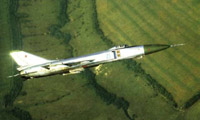
Soviet's Air Defense Backbone
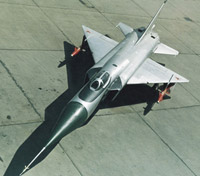
Delta winged interceptor with R-98 missiles
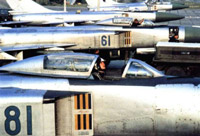
Su-15TM in operational service
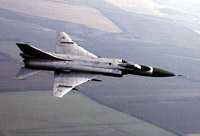
Cranked delta wing

Su-15TM with ogive-shaped radome
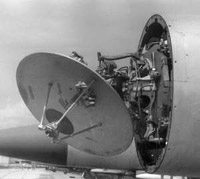
Oryol-D58M nose radar

Photo of the cockpit, note the radar sight

Su-15UT
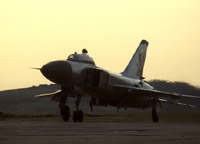
Perciscope extended
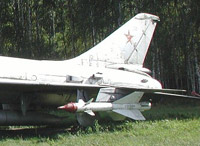
Su-15 with R-98 on underwing station
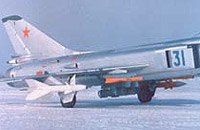
Su-15TM with R-98M, R-60 and bombs



 Back to Index
Back to Index